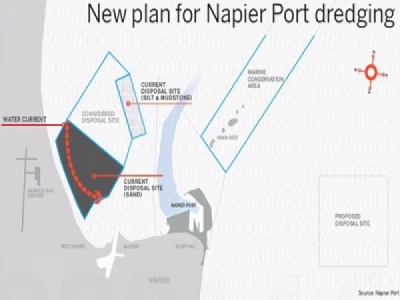
Posted on May 23, 2017
By Patrick O'Sullivan, Hawke's Bay Today
Napier Port has changed its mind on where it wants to dispose of 3 million cubic metres of dredged sea floor.
The removal of sea floor, primarily silt and mudstone, would create a channel to a 350m wharf needed to grow the Hawke’s Bay Regional Council-owned port’s capacity and to berth bigger ships.
Port chief executive Garth Cowie said originally it planned to dump the material off Westshore Beach north of Napier, beside the present site for maintenance dredging, but after community input and scientific analysis it was decided the Westshore site had the potential to affect water quality.
Commissioned studies identified the majority of dredged material for the new wharf was not suitable for renourishing Westshore Beach and much of it would be carried anti-clockwise, first south and then east and potentially back towards the port’s shipping channel, he said.
Suspended material had the potential to cross the shipping channel towards Pania Reef.
The proposed alternate site is further away in 20m water less affected by large storms.
Any drift potential was southerly, away from Pania.
The new wharf and its associated dredging programme is estimated to cost $100 million and is the biggest single investment since the port was established in 1886, but the scale is a fraction of similar port developments because the Napier seafloor quickly deepens.
Mr Cowie said over the last 15 months the port conducted a pre-consultation process prior to lodging resource consent applications, speaking with stakeholders and about 2000 local people. That led to further discussions with divers and recreational fishers who raised concern at the volume of dredged material deposited close to shore.
The port shared the concern and commissioned further reports enabling “a far stronger” resource consent application.
“The investigations have helped us to understand how effective depositing dredge material near the shore may have been in re-nourishing Westshore Beach, as well as where the different types of sediment are likely to end up.”
Dredging over the last decade has yielded small volumes of sand and fine silt “however, we now know from new monitoring and improved modelling techniques that disposing of the material at the Westshore disposal site is not having any long-term benefits to the beach”.
“The studies showed coarser sand that ended up on the beach was providing nourishment for a period before being carried north along the coast by wave action.”
Resource consent applications are due to be filed in June and the new wharf operational by 2020 if all goes to plan. To smooth the way the port commissioned 19 scientific reports – all currently under independent review – covering potential impacts on the marine life, dredging and dredging plume impacts, waves and coastal processes, surf breaks, noise and traffic and a Cultural Impact Assessment carried out by hapu.
The reef has been mapped both physically and ecologically and real time sensors are in place to monitor water quality.
Port cargo has been projected to increase 49 per cent by 2026 and cruise lines have indicated ships of more than 360m will visit Napier in the next five years.
While there has been speculation the cost of the development would require a partial sale of the port, Mr Cowie was confident it could be paid for through debt and a reduced dividend to its owner.
Source: Hawke’s Bay Today





